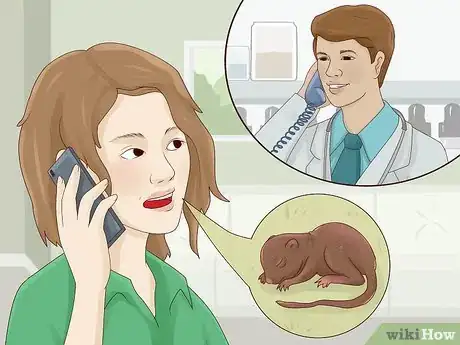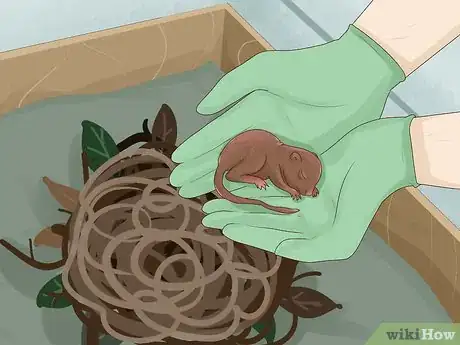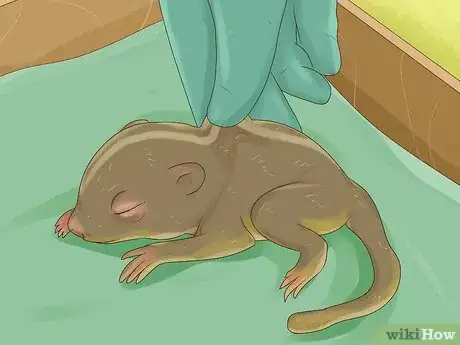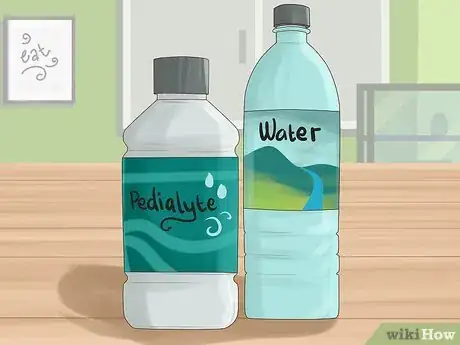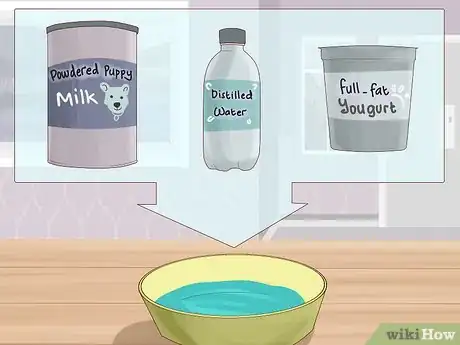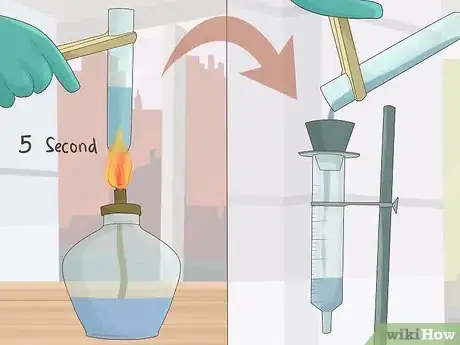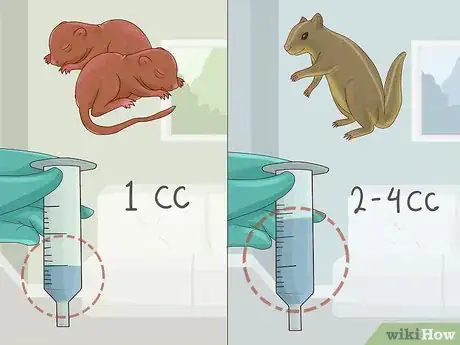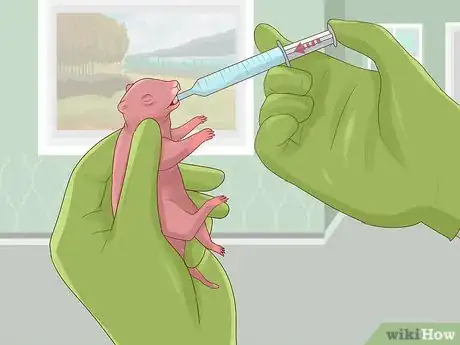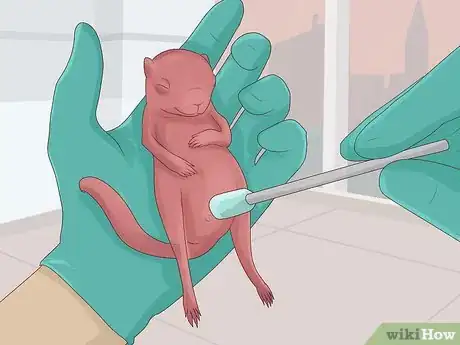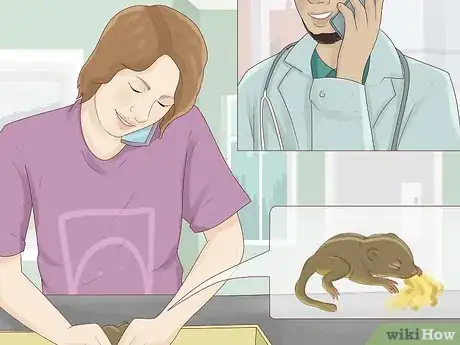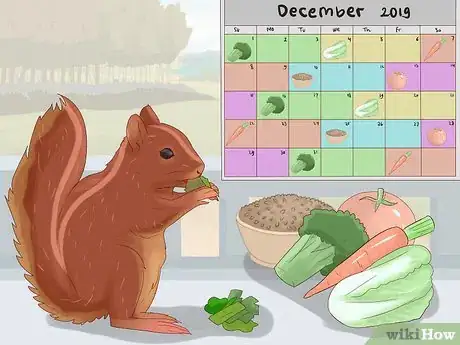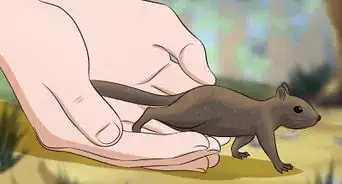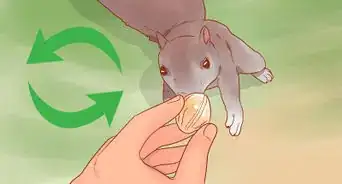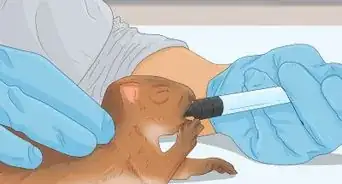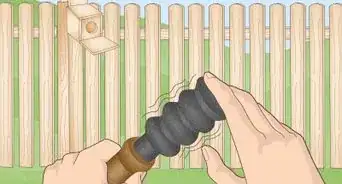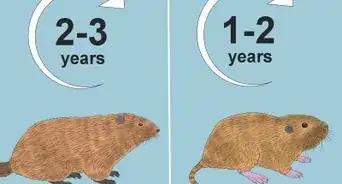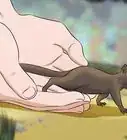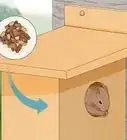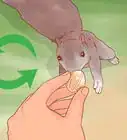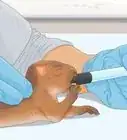This article was co-authored by wikiHow staff writer, Christopher M. Osborne, PhD. Christopher Osborne has been a wikiHow Content Creator since 2015. He is also a historian who holds a PhD from The University of Notre Dame and has taught at universities in and around Pittsburgh, PA. His scholarly publications and presentations focus on his research interests in early American history, but Chris also enjoys the challenges and rewards of writing wikiHow articles on a wide range of subjects.
This article has been viewed 44,062 times.
Learn more...
Squirrels are wild animals that live their best lives in the wild, rather than being kept as pets. If you find a baby squirrel that you’re sure needs care, contact a wildlife rehabilitator first to get expert guidance. Prepare a rehydrating solution or milk replacement formula as advised, and feed the squirrel slowly, carefully, and frequently as directed. After several weeks, you can slowly introduce solid foods, once again with the rehabilitator’s guidance.
Steps
Preparing for the Initial Feeding
-
1Contact a wildlife rehabilitator before taking in a wild squirrel. Search online for “wildlife rehabilitators near me,” or contact your government’s environmental, wildlife, or similar agency. Help the squirrel only if advised, and only as advised. Despite your good intentions, there are many reasons why you should consult an expert before choosing to help a baby squirrel, including:[1]
- A baby squirrel that appears to be orphaned or in need of help may not be. Its mother may simply be hiding nearby, waiting for you to leave.
- Baby squirrels require round-the-clock care for the first several weeks of life.
- It is very difficult to care for a baby squirrel and then successfully reintroduce it into the wild. It simply won’t have the skills it needs.
- Taking in or caring for squirrels—and other wild animals—may be illegal where you live. You may be subject to fines or even jail time.
-
2Pick up and shelter the baby squirrel only if advised to do so. If and only if the wildlife rehabilitator you’ve contacted advises it, pick up the baby squirrel and create a temporary nest for it. Do the following:
- Gather up some nesting material (twigs, straw, leaves, etc.) and stick it in your pocket.
- Scoop up the baby squirrel very gently in both hands. Wear gloves if at all possible, and wash your hands as soon as you can.
- Gently carry the squirrel home, and place it in a small container, like a shoebox or—better yet—a plastic storage container. Poke numerous holes in the lid.
- Make a nest in half of the box, using the material in your pocket. Gently move the squirrel into the nest.
- Set the other half of the box (without the nest) on top of a heating pad set to low or medium. Your goal is to warm that half of the box to 99 °F (37 °C).
Advertisement -
3Check for dehydration, as advised by the wildlife rehabilitator. They may advise you to check for dehydration by gently pinching the baby squirrel’s skin. If the pinched skin remains raised (or “tented”) for more than 1 second, the squirrel is likely dehydrated.[2]
- If the pinched skin falls quickly, the squirrel most likely isn’t dehydrated. Skip providing hydration unless advised by the wildlife rehabilitator.
-
4Use Pedialyte, water, or a homemade mix if you need a rehydrating solution. Water will work for rehydration, but a pediatric electrolyte solution (like Pedialyte) is a better choice. Do not use a sports drink like Gatorade.[3]
- You can also make your own rehydrating solution by stirring together 1 tsp (5 mg) of salt, 1 tbsp (15 mg) of sugar, and 1 qt (1 l) of warm water. Store this mixture in the refrigerator.
- Use one of these options only if the squirrel needs rehydrated. Do not use it for regular feedings.
-
5Use powdered puppy milk replacer if the baby squirrel is hydrated. If the baby squirrel doesn’t require rehydration, you can move straight to providing this formula. Or, once you’ve completed the process of rehydrating the squirrel, you’ll also shift to this formula. Buy powdered puppy milk replacer at any pet store, and make the following mixture:[4]
- 8 oz (230 g) of powdered puppy milk replacer, 16 fl oz (470 ml) of distilled water, and 2 fl oz (59 ml) of whipping cream (not whipped cream) or plain, full-fat yogurt.
- Stir the mixture together thoroughly and store it in the refrigerator for up to 3 days.
-
6Warm a small amount of liquid and fill a 1 cc (1 ml) oral syringe. Draw up enough Pedialyte, water, homemade rehydrator, or formula to fill a 1 cc (or 1 ml—they’re equivalent) oral syringe (medicine dropper). Dispense it into a small, microwave-safe bowl, and heat it for 5 seconds. Draw it back into the dropper and squeeze a drop on your wrist to test the temperature.[5]
- If the solution feels cold to your skin, reheat it in the bowl for 5 more seconds.
- If it is uncomfortably warm on your skin, wait until it is comfortably warm before feeding it to the squirrel.
- If the baby squirrel is more than 2 weeks old, its eyes are open, and it has fur, use a 2-4 cc (ml) oral syringe instead.
Feeding the Right Amount in the Right Way
-
1Draw the appropriate amount of liquid into the dropper, based on age. Once your rehydrating solution or milk replacer formula is mixed and warmed, use the measurement lines on the oral syringe to get the right amount for a feeding. First and foremost, follow the recommendations of the wildlife rehabilitator that you’ve contacted. The general guidelines are as follows:[6]
- Tiny, pink-skinned, eyes-closed babies under 2 weeks of age should get 0.5 to 1 cc (ml) every 2 hours.
- Open-eyed, fully-furred babies from 2-6 weeks of age should get 2-4 cc (ml) every 3 hours.
- From about 6 weeks of age until the baby is weaned, feed them 4-5 cc (ml) every 4 hours.
- This includes night feedings until at least 6 weeks of age!
-
2Hold the baby upright and point the dropper toward the roof of its mouth. It’s very easy for baby squirrels—especially tiny, hairless, pink newborns—to aspirate the feeding liquid, which can lead to pneumonia and death. Keeping the squirrel upright will make aspiration less likely.[7]
- Pick up the squirrel very gently and cradle it just tightly enough to keep it secure.
- You can use your thumb to help keep the squirrel’s head tilted slightly upward, but do so gently.
- Wash your hands before and after handling the squirrel. Even better, wear latex or thin leather gloves.
- If the wildlife rehabilitator has alternate feeding instructions, follow them.
-
3Dispense the feeding liquid very slowly to prevent aspiration or choking. For a hairless, pink baby, place just one drop at a time on its lips. If the baby has fur and its eyes are open, you can place the dropper just past its lips and squeeze 3-4 drops at a time.[8]
- At a one-drop-at-a-time pace, it may take up to an hour to complete a feeding—so be prepared!
- If the liquid is running out of the squirrel’s mouth or especially its nose, you’re feeding it much too rapidly. Blot off the excess liquid and wait about 1 minute before resuming.
-
4Stimulate a newborn squirrel’s bowels after each feeding. If the squirrel’s eyes are still closed, it will need external stimulation—which is provided in the wild by its mother—to urinate and defecate. After each feeding, gently rub the newborn’s genital and anal area with a cotton ball or cotton swab dipped in warm water until it urinates or defecates. Wipe away the tiny mess with a damp cloth.[9]
- Once the squirrel’s eyes are open, it should urinate and defecate without stimulation.
-
5Get the wildlife rehabilitator involved if there are feeding problems. If the baby squirrel gags when you try to feed it, or shows no interest in feeding, immediately contact the wildlife rehabilitator again. Your best option is always to get the squirrel to the rehabilitator so they can care for it properly, but this is especially the case if there are feeding problems.[10]
- Likewise, if the squirrel won’t urinate or defecate, even with stimulation, get the rehabilitator’s help right away.
Weaning a Baby Squirrel
-
1Choose the first solid food based on the rehabilitator’s recommendation. Different wildlife rehabilitators have different preferences regarding the best solid food to introduce to a baby squirrel first. They’ll nearly always recommend packaged feeding blocks, which you can buy at pet retailers. However, some experts prefer feeding blocks meant for rodents, while others insist on squirrel-specific feeding blocks (which you may need to order online).[11]
- They may also have a specific brand recommendation, and possibly advice on the best place to get the feeding blocks.
-
2Try to introduce solid food once the squirrel’s eyes open. Most baby squirrels open their eyes fully at around 4-5 weeks of age. Once this happens, place your chosen feeding block into the squirrel’s enclosure after giving it a feeding with the dropper. Don’t worry if it shows no interest at first. Before long, it will start nibbling on the block.[12]
- Also introduce a water source into the enclosure once you add the food block. Keep a shallow dish of fresh water in the enclosure, and replace it at least once daily.[13]
- Keep feeding the squirrel formula on the set schedule—by this point, likely every 4 hours—until it shows no interest in the formula. It’ll likely lose interest in formula and only want solid food at 7-10 weeks of age.
-
3Introduce veggies and other healthy foods one at a time. After the squirrel has taken to the feeding blocks, start adding small, ripped-up pieces of broccoli, kale, spring mix, or other dark greens. Start with one veggie at a time (kale, for instance), and wait 2-3 days before trying another one. After that, you can offer seeds, small nuts, and cut-up pieces of fruit one at a time.[14]
- These other foods should supplement the feeding blocks, not replace them. Just add a few pieces at a time.
- Providing new foods one at a time makes it easier to determine if the squirrel has a bad response to a particular food. Diarrhea is usually the most obvious sign of this.
-
4Take the squirrel to a rehabilitator to be released into the wild. Once the squirrel is weaned, it’s ready to go back into the wild. This is a very challenging transition, however, and you should let an expert handle the process. Contact the rehabilitator for guidance on transferring the squirrel to their care.
- Your other alternative at this point is to take in the squirrel as a pet. This may be illegal where you live, however, and squirrels are very demanding pets regardless. It will likely live a better life in the wild.[15]
Things You’ll Need
- Oral syringe (1 cc or 2-4 cc)
- Pedialyte or similar hydration solution
- Powdered puppy milk replacer
- Shallow water dish
- Squirrel enclosure
References
- ↑ http://animalpetdoctor.homestead.com/squirrels.html
- ↑ http://www.squirrel-rehab.org/rehabinfo/infantfeeding.html
- ↑ http://www.squirrel-rehab.org/rehabinfo/infantfeeding.html
- ↑ http://animalpetdoctor.homestead.com/squirrels.html
- ↑ http://www.squirrel-rehab.org/rehabinfo/infantfeeding.html
- ↑ http://www.squirrel-rehab.org/rehabinfo/infantfeeding.html
- ↑ http://animalpetdoctor.homestead.com/squirrels.html
- ↑ http://animalpetdoctor.homestead.com/squirrels.html
- ↑ http://animalpetdoctor.homestead.com/squirrels.html
- ↑ http://animalpetdoctor.homestead.com/squirrels.html
- ↑ http://animalpetdoctor.homestead.com/squirrels.html
- ↑ http://animalpetdoctor.homestead.com/squirrels.html
- ↑ https://animals.mom.me/raising-squirrels-pets-1619.html
- ↑ http://animalpetdoctor.homestead.com/squirrels.html
- ↑ https://animals.mom.me/raising-squirrels-pets-1619.html
